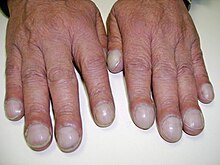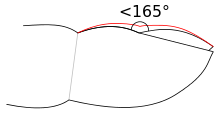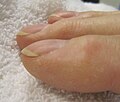Nail clubbing
| Clubbing | |
|---|---|
| Other names | Drumstick fingers/toes, Hippocratic fingers/toes, digital clubbing, watch-glass nails[1] |
 | |
| Clubbing | |
| Specialty | Pulmonology |
Nail clubbing, also known as digital clubbing or clubbing, is a deformity of the finger or toe
Clubbing is associated with lung cancer, lung infections, interstitial lung disease, cystic fibrosis, or cardiovascular disease.[5] Clubbing may also run in families,[5] and occur unassociated with other medical problems.[6][7]
The incidence of clubbing is unknown; it was present in about 1% of people admitted to an internal medicine unit of a hospital.[5] Clubbing has been recognized as a sign of disease since the time of Hippocrates.[5]
Causes
Clubbing is associated with
- Lung disease:
- Lung cancer[8]
- Interstitial lung disease most commonly idiopathic pulmonary fibrosis
- Complicated tuberculosis
- Suppurative lung disease: lung abscess, empyema, bronchiectasis, cystic fibrosis
- Mesothelioma of the pleura
- Arteriovenous fistula or malformation
- Sarcoidosis
- Heart disease:
- Any disease featuring chronic hypoxia
- Congenital cyanotic heart disease(most common cardiac cause)
- Subacute bacterial endocarditis
- Atrial myxoma(benign tumor)
- Tetralogy of Fallot
- Any disease featuring chronic
- Gastrointestinal and hepatobiliary:
- Malabsorption
- Crohn's disease and ulcerative colitis
- Cirrhosis, especially in primary biliary cholangitis[9]
- Hepatopulmonary syndrome, a complication of cirrhosis[10]
- Others:
- Graves' disease (autoimmune hyperthyroidism) – in this case it is known as thyroid acropachy[11]
- Familial and hereditary clubbing and "pseudoclubbing" (people of African descent often have what appears to be clubbing)
- Vascular anomalies of the affected arm such as an axillary artery aneurysm (in unilateral clubbing)
Nail clubbing is not specific to chronic obstructive pulmonary disease (COPD). Therefore, in patients with COPD and significant degrees of clubbing, a search for signs of bronchogenic carcinoma (or other causes of clubbing) might still be indicated.[12] A congenital form has also been recognized.[13]
Hypertrophic pulmonary osteoarthropathy
A special form of clubbing is
Primary hypertrophic osteoarthropathy
Primary hypertrophic osteoarthropathy is HPOA without signs of pulmonary disease. This form has a hereditary component, although subtle cardiac abnormalities can occasionally be found. It is known eponymously as the Touraine–Solente–Golé syndrome. This condition has been linked to mutations in the gene on the fourth chromosome (4q33-q34) coding for the enzyme
Pathogenesis
The exact cause for sporadic clubbing is unknown. Theories as to its cause include:
- Vasodilation (i.e., distended blood vessels).[citation needed]
- Secretion of growth factors (e.g., platelet-derived growth factor and hepatocyte growth factor) from the lungs.[citation needed]
- Overproduction of prostaglandin E2 by other tissues.[14]
- Increased entry of megakaryocytes into the systemic circulation. Under normal circumstances in healthy individuals, megakaryocytes that arise from the bone marrow are trapped in the pulmonary capillary bed and broken down before they enter the systemic circulation. It is thought that in disorders where there is right-to-left shunting or lung malignancy, the megakaryocytes can bypass the breakdown within the pulmonary circulation and enter the systemic circulation. They are then trapped within the capillary beds within the extremities, such as the digits, and release platelet-derived growth factor (PDGF) and vascular endothelial growth factor (VEGF). PDGF and VEGF have growth promoting properties and cause connective tissue hypertrophy and capillary permeability.[15]
Diagnosis


When clubbing is observed, pseudoclubbing[
Stages
Clubbing is present in one of five stages:[12]
- No visible clubbing - Fluctuation (increased ballotability) and softening of the nail bed only. No visible changes of nails.
- Mild clubbing - Loss of the normal <165° angle (Lovibond angle) between the nailbed and the fold (cuticula). Schamroth's window (see below) is obliterated. Clubbing is not obvious at a glance.
- Moderate clubbing - Increased convexity of the nail fold. Clubbing is apparent at a glance.
- Gross clubbing - Thickening of the whole distal (end part of the) finger (resembling a drumstick)
- Hypertrophic osteoarthropathy - Shiny aspect and striation of the nail and skin
Schamroth's sign or Schamroth's window test (originally demonstrated by South African cardiologist
-
Severe clubbing
-
Front view
-
Side views
-
Cyanotic nail beds
Epidemiology
The exact frequency of clubbing in the population is not known. A 2008 study found clubbing in 1%, or 15 patients, of 1511 patients admitted to a department of internal medicine in Belgium. Of these, 40%, or 6 patients, turned out to have significant underlying disease of various causes, while 60%, or 9 patients, had no medical problems on further investigations and remained well over the subsequent year.[7]
History
At least since the time of Hippocrates, clubbing has been recognized as a sign of disease.[5] The phenomenon has been called "Hippocratic fingers".

The Dutch painter Dick Ket had nail clubbing as is seen from his paintings. He had an underlying disease, probably dextrocardia.[17]
See also
- Clubbed thumb(unrelated congenital deformity)
References
- ISBN 978-1-4160-2999-1.
- PMID 23671180.
- ISBN 0-07-138076-0. : 656
- PMID 31082012.
- ^ PMID 30969535.
- ^ Schwatz RA. "Clubbing of the Nails". Medscape. Retrieved 14 August 2014.
- ^ PMID 18549933.
- PMID 9872183.
- PMID 7227854.
- PMID 12715285.
- ^ "acropachy". GPnotebook.
- ^ PMID 11466101.
- S2CID 28251025.
- ^ S2CID 23484059.
- S2CID 43847925.
- PMID 1265563.
- ^ (in Dutch) Dick Ket, een schilder en zijn ziekte W.H.D. de Haas, Nederlands Tijdschrift voor Geneeskunde, 1984




